Engineering Innovations and Ethics: Hurricane Katrina Analysis
VerifiedAdded on 2021/01/01
|14
|2954
|398
Report
AI Summary
This report examines the devastating impact of Hurricane Katrina, focusing on the engineering failures and ethical considerations that contributed to the disaster. It analyzes the role of engineering innovations in managing destructive disasters, particularly in the context of coastal regions and climate change. The report delves into ethical considerations for engineers, emphasizing integrity, competent practices, sustainability, and leadership. It identifies the challenges Australia faces in addressing similar disasters and provides future recommendations, including regular surveillance, ethical practices, promotion of sustainability, and government support for sustainable engineering. The report highlights the need for improved engineering designs, disaster management strategies, and climate change adaptation to mitigate the impact of future hurricanes.
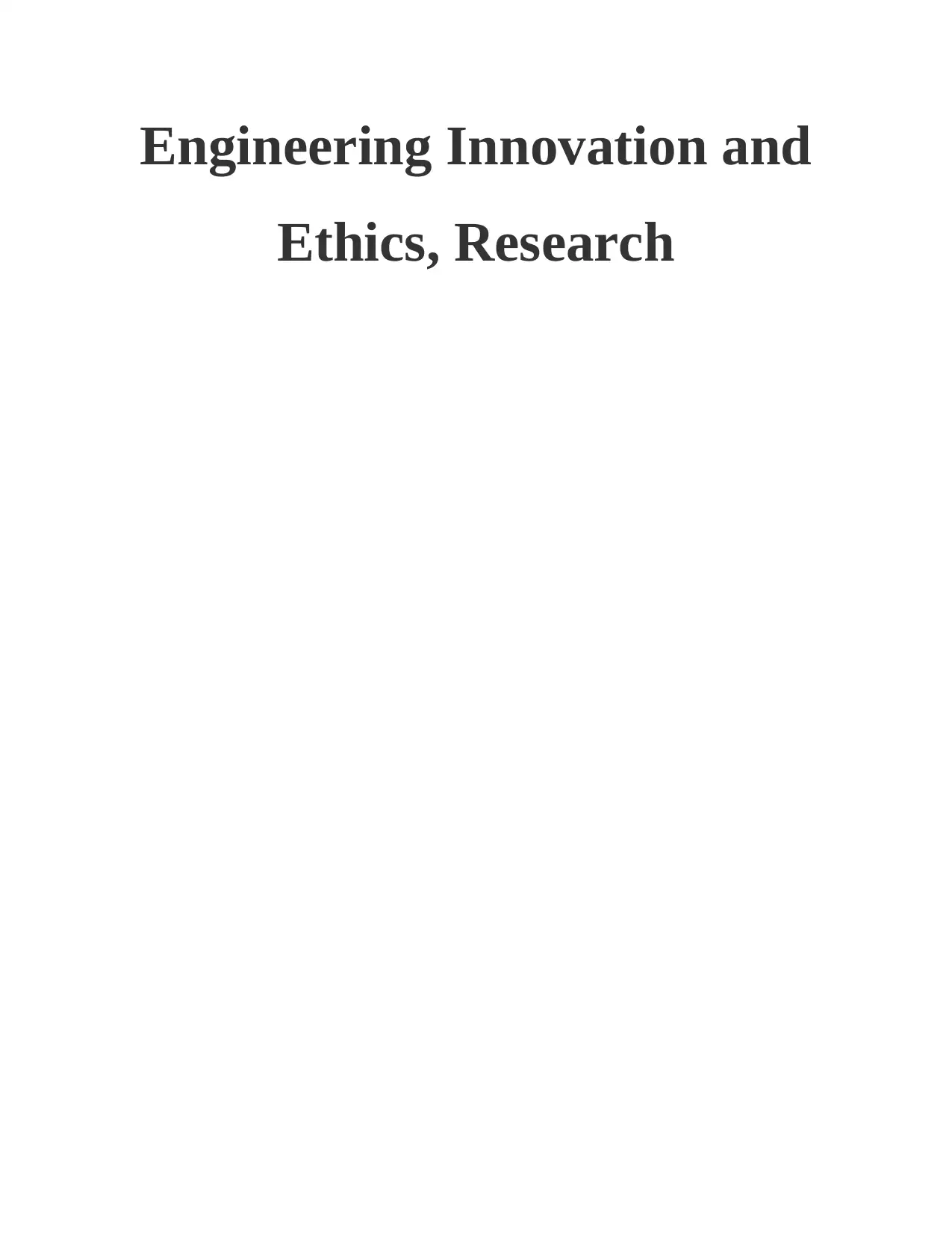
Engineering Innovation and
Ethics, Research
Ethics, Research
Paraphrase This Document
Need a fresh take? Get an instant paraphrase of this document with our AI Paraphraser
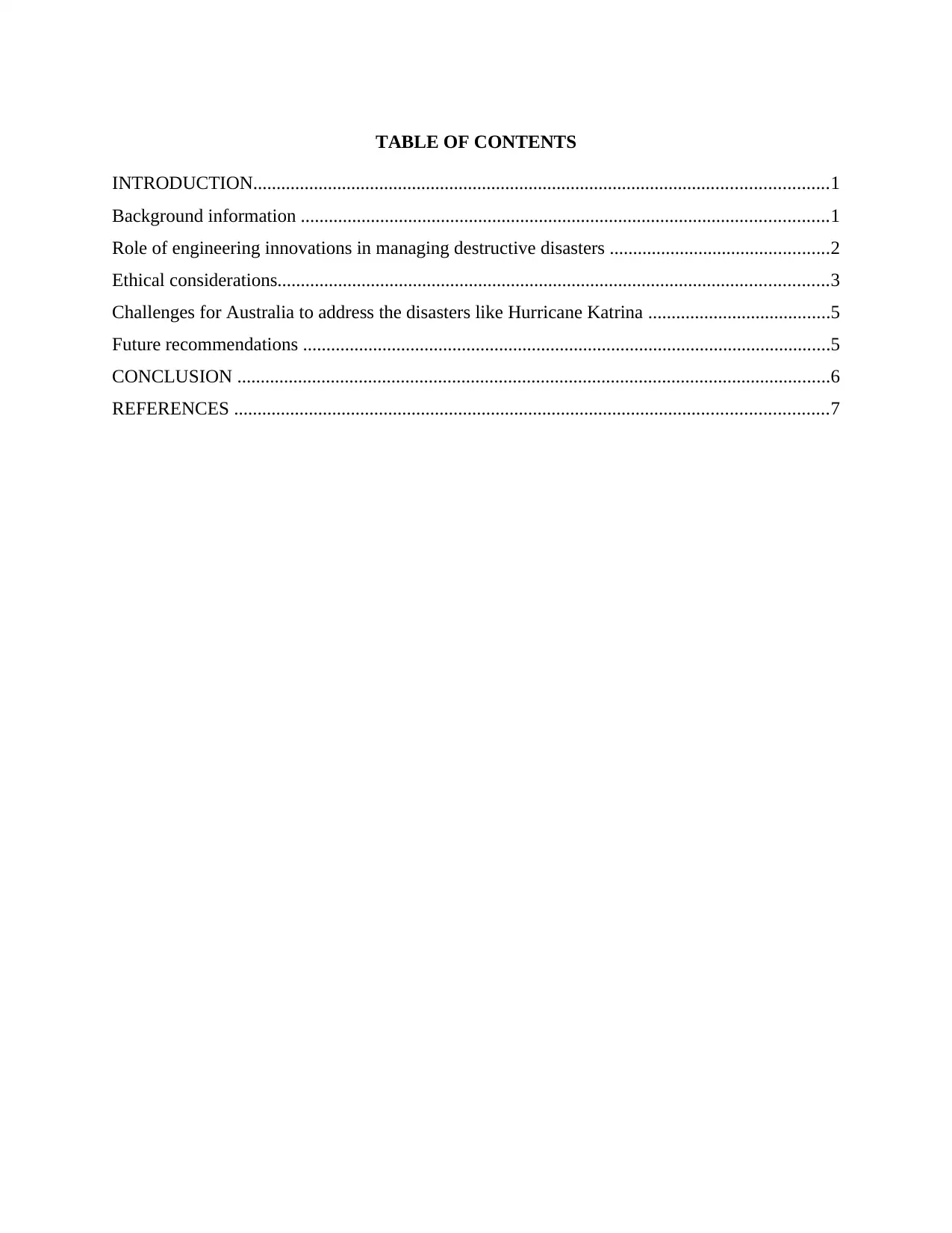
TABLE OF CONTENTS
INTRODUCTION...........................................................................................................................1
Background information .................................................................................................................1
Role of engineering innovations in managing destructive disasters ...............................................2
Ethical considerations......................................................................................................................3
Challenges for Australia to address the disasters like Hurricane Katrina .......................................5
Future recommendations .................................................................................................................5
CONCLUSION ...............................................................................................................................6
REFERENCES ...............................................................................................................................7
INTRODUCTION...........................................................................................................................1
Background information .................................................................................................................1
Role of engineering innovations in managing destructive disasters ...............................................2
Ethical considerations......................................................................................................................3
Challenges for Australia to address the disasters like Hurricane Katrina .......................................5
Future recommendations .................................................................................................................5
CONCLUSION ...............................................................................................................................6
REFERENCES ...............................................................................................................................7
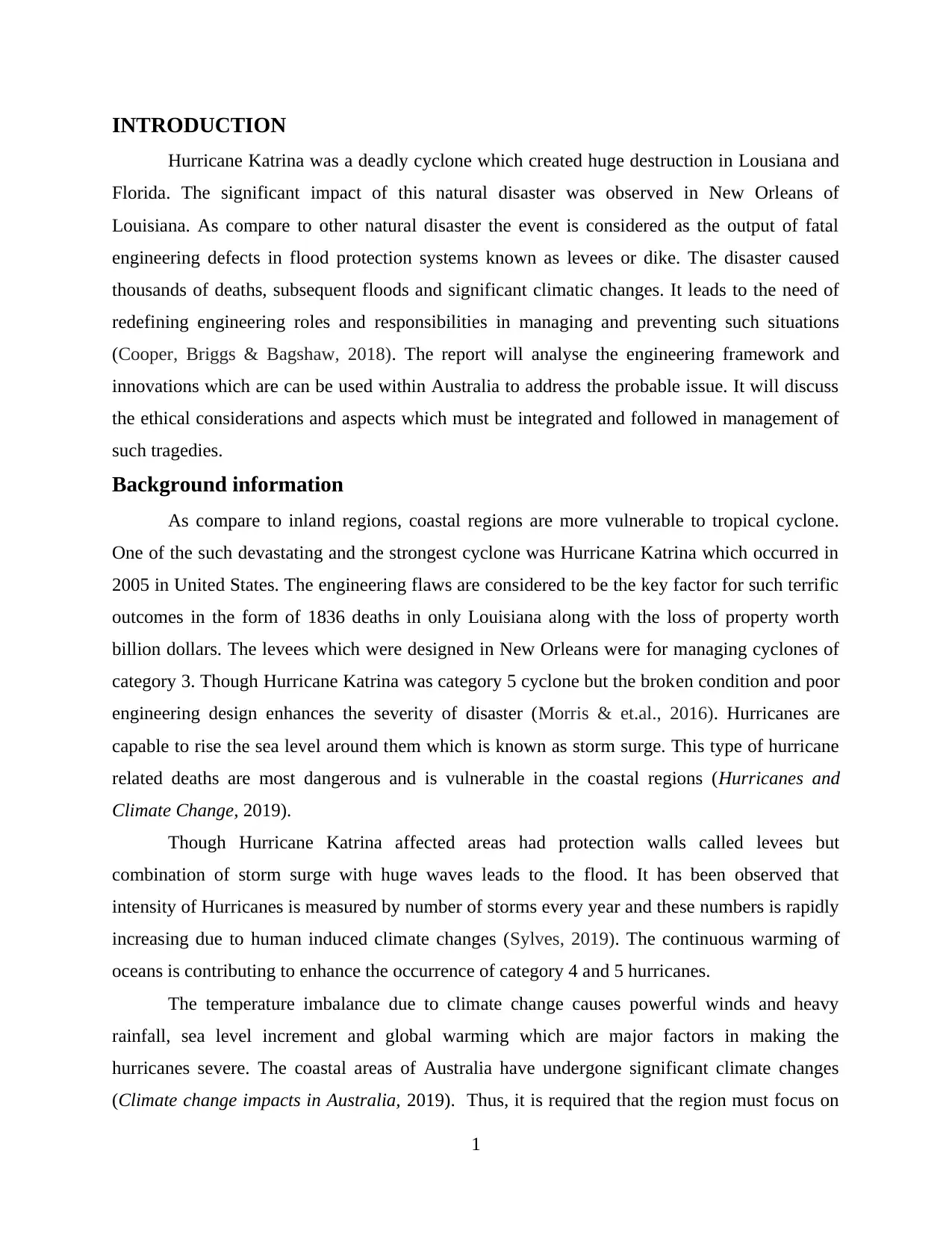
INTRODUCTION
Hurricane Katrina was a deadly cyclone which created huge destruction in Lousiana and
Florida. The significant impact of this natural disaster was observed in New Orleans of
Louisiana. As compare to other natural disaster the event is considered as the output of fatal
engineering defects in flood protection systems known as levees or dike. The disaster caused
thousands of deaths, subsequent floods and significant climatic changes. It leads to the need of
redefining engineering roles and responsibilities in managing and preventing such situations
(Cooper, Briggs & Bagshaw, 2018). The report will analyse the engineering framework and
innovations which are can be used within Australia to address the probable issue. It will discuss
the ethical considerations and aspects which must be integrated and followed in management of
such tragedies.
Background information
As compare to inland regions, coastal regions are more vulnerable to tropical cyclone.
One of the such devastating and the strongest cyclone was Hurricane Katrina which occurred in
2005 in United States. The engineering flaws are considered to be the key factor for such terrific
outcomes in the form of 1836 deaths in only Louisiana along with the loss of property worth
billion dollars. The levees which were designed in New Orleans were for managing cyclones of
category 3. Though Hurricane Katrina was category 5 cyclone but the broken condition and poor
engineering design enhances the severity of disaster (Morris & et.al., 2016). Hurricanes are
capable to rise the sea level around them which is known as storm surge. This type of hurricane
related deaths are most dangerous and is vulnerable in the coastal regions (Hurricanes and
Climate Change, 2019).
Though Hurricane Katrina affected areas had protection walls called levees but
combination of storm surge with huge waves leads to the flood. It has been observed that
intensity of Hurricanes is measured by number of storms every year and these numbers is rapidly
increasing due to human induced climate changes (Sylves, 2019). The continuous warming of
oceans is contributing to enhance the occurrence of category 4 and 5 hurricanes.
The temperature imbalance due to climate change causes powerful winds and heavy
rainfall, sea level increment and global warming which are major factors in making the
hurricanes severe. The coastal areas of Australia have undergone significant climate changes
(Climate change impacts in Australia, 2019). Thus, it is required that the region must focus on
1
Hurricane Katrina was a deadly cyclone which created huge destruction in Lousiana and
Florida. The significant impact of this natural disaster was observed in New Orleans of
Louisiana. As compare to other natural disaster the event is considered as the output of fatal
engineering defects in flood protection systems known as levees or dike. The disaster caused
thousands of deaths, subsequent floods and significant climatic changes. It leads to the need of
redefining engineering roles and responsibilities in managing and preventing such situations
(Cooper, Briggs & Bagshaw, 2018). The report will analyse the engineering framework and
innovations which are can be used within Australia to address the probable issue. It will discuss
the ethical considerations and aspects which must be integrated and followed in management of
such tragedies.
Background information
As compare to inland regions, coastal regions are more vulnerable to tropical cyclone.
One of the such devastating and the strongest cyclone was Hurricane Katrina which occurred in
2005 in United States. The engineering flaws are considered to be the key factor for such terrific
outcomes in the form of 1836 deaths in only Louisiana along with the loss of property worth
billion dollars. The levees which were designed in New Orleans were for managing cyclones of
category 3. Though Hurricane Katrina was category 5 cyclone but the broken condition and poor
engineering design enhances the severity of disaster (Morris & et.al., 2016). Hurricanes are
capable to rise the sea level around them which is known as storm surge. This type of hurricane
related deaths are most dangerous and is vulnerable in the coastal regions (Hurricanes and
Climate Change, 2019).
Though Hurricane Katrina affected areas had protection walls called levees but
combination of storm surge with huge waves leads to the flood. It has been observed that
intensity of Hurricanes is measured by number of storms every year and these numbers is rapidly
increasing due to human induced climate changes (Sylves, 2019). The continuous warming of
oceans is contributing to enhance the occurrence of category 4 and 5 hurricanes.
The temperature imbalance due to climate change causes powerful winds and heavy
rainfall, sea level increment and global warming which are major factors in making the
hurricanes severe. The coastal areas of Australia have undergone significant climate changes
(Climate change impacts in Australia, 2019). Thus, it is required that the region must focus on
1
⊘ This is a preview!⊘
Do you want full access?
Subscribe today to unlock all pages.

Trusted by 1+ million students worldwide
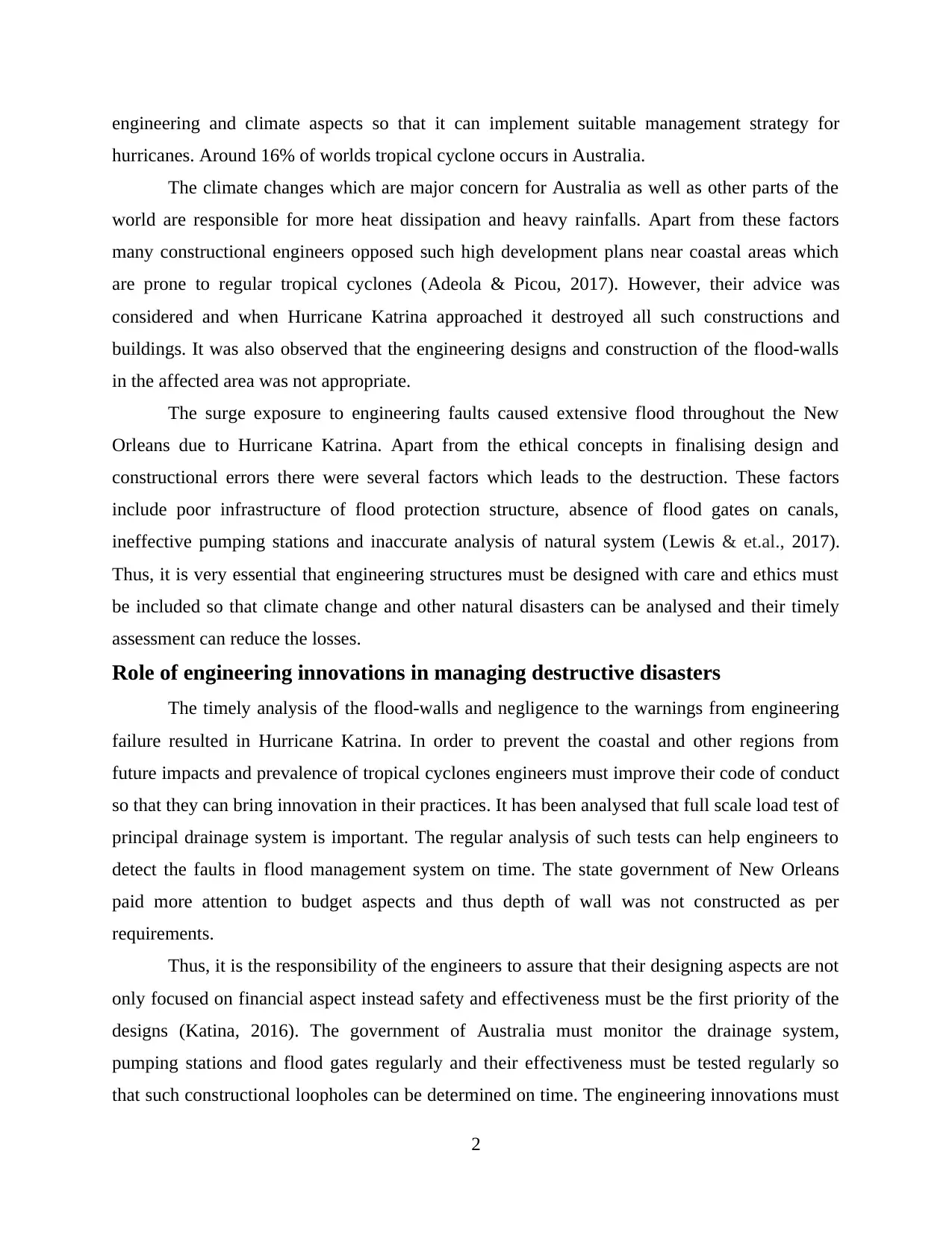
engineering and climate aspects so that it can implement suitable management strategy for
hurricanes. Around 16% of worlds tropical cyclone occurs in Australia.
The climate changes which are major concern for Australia as well as other parts of the
world are responsible for more heat dissipation and heavy rainfalls. Apart from these factors
many constructional engineers opposed such high development plans near coastal areas which
are prone to regular tropical cyclones (Adeola & Picou, 2017). However, their advice was
considered and when Hurricane Katrina approached it destroyed all such constructions and
buildings. It was also observed that the engineering designs and construction of the flood-walls
in the affected area was not appropriate.
The surge exposure to engineering faults caused extensive flood throughout the New
Orleans due to Hurricane Katrina. Apart from the ethical concepts in finalising design and
constructional errors there were several factors which leads to the destruction. These factors
include poor infrastructure of flood protection structure, absence of flood gates on canals,
ineffective pumping stations and inaccurate analysis of natural system (Lewis & et.al., 2017).
Thus, it is very essential that engineering structures must be designed with care and ethics must
be included so that climate change and other natural disasters can be analysed and their timely
assessment can reduce the losses.
Role of engineering innovations in managing destructive disasters
The timely analysis of the flood-walls and negligence to the warnings from engineering
failure resulted in Hurricane Katrina. In order to prevent the coastal and other regions from
future impacts and prevalence of tropical cyclones engineers must improve their code of conduct
so that they can bring innovation in their practices. It has been analysed that full scale load test of
principal drainage system is important. The regular analysis of such tests can help engineers to
detect the faults in flood management system on time. The state government of New Orleans
paid more attention to budget aspects and thus depth of wall was not constructed as per
requirements.
Thus, it is the responsibility of the engineers to assure that their designing aspects are not
only focused on financial aspect instead safety and effectiveness must be the first priority of the
designs (Katina, 2016). The government of Australia must monitor the drainage system,
pumping stations and flood gates regularly and their effectiveness must be tested regularly so
that such constructional loopholes can be determined on time. The engineering innovations must
2
hurricanes. Around 16% of worlds tropical cyclone occurs in Australia.
The climate changes which are major concern for Australia as well as other parts of the
world are responsible for more heat dissipation and heavy rainfalls. Apart from these factors
many constructional engineers opposed such high development plans near coastal areas which
are prone to regular tropical cyclones (Adeola & Picou, 2017). However, their advice was
considered and when Hurricane Katrina approached it destroyed all such constructions and
buildings. It was also observed that the engineering designs and construction of the flood-walls
in the affected area was not appropriate.
The surge exposure to engineering faults caused extensive flood throughout the New
Orleans due to Hurricane Katrina. Apart from the ethical concepts in finalising design and
constructional errors there were several factors which leads to the destruction. These factors
include poor infrastructure of flood protection structure, absence of flood gates on canals,
ineffective pumping stations and inaccurate analysis of natural system (Lewis & et.al., 2017).
Thus, it is very essential that engineering structures must be designed with care and ethics must
be included so that climate change and other natural disasters can be analysed and their timely
assessment can reduce the losses.
Role of engineering innovations in managing destructive disasters
The timely analysis of the flood-walls and negligence to the warnings from engineering
failure resulted in Hurricane Katrina. In order to prevent the coastal and other regions from
future impacts and prevalence of tropical cyclones engineers must improve their code of conduct
so that they can bring innovation in their practices. It has been analysed that full scale load test of
principal drainage system is important. The regular analysis of such tests can help engineers to
detect the faults in flood management system on time. The state government of New Orleans
paid more attention to budget aspects and thus depth of wall was not constructed as per
requirements.
Thus, it is the responsibility of the engineers to assure that their designing aspects are not
only focused on financial aspect instead safety and effectiveness must be the first priority of the
designs (Katina, 2016). The government of Australia must monitor the drainage system,
pumping stations and flood gates regularly and their effectiveness must be tested regularly so
that such constructional loopholes can be determined on time. The engineering innovations must
2
Paraphrase This Document
Need a fresh take? Get an instant paraphrase of this document with our AI Paraphraser
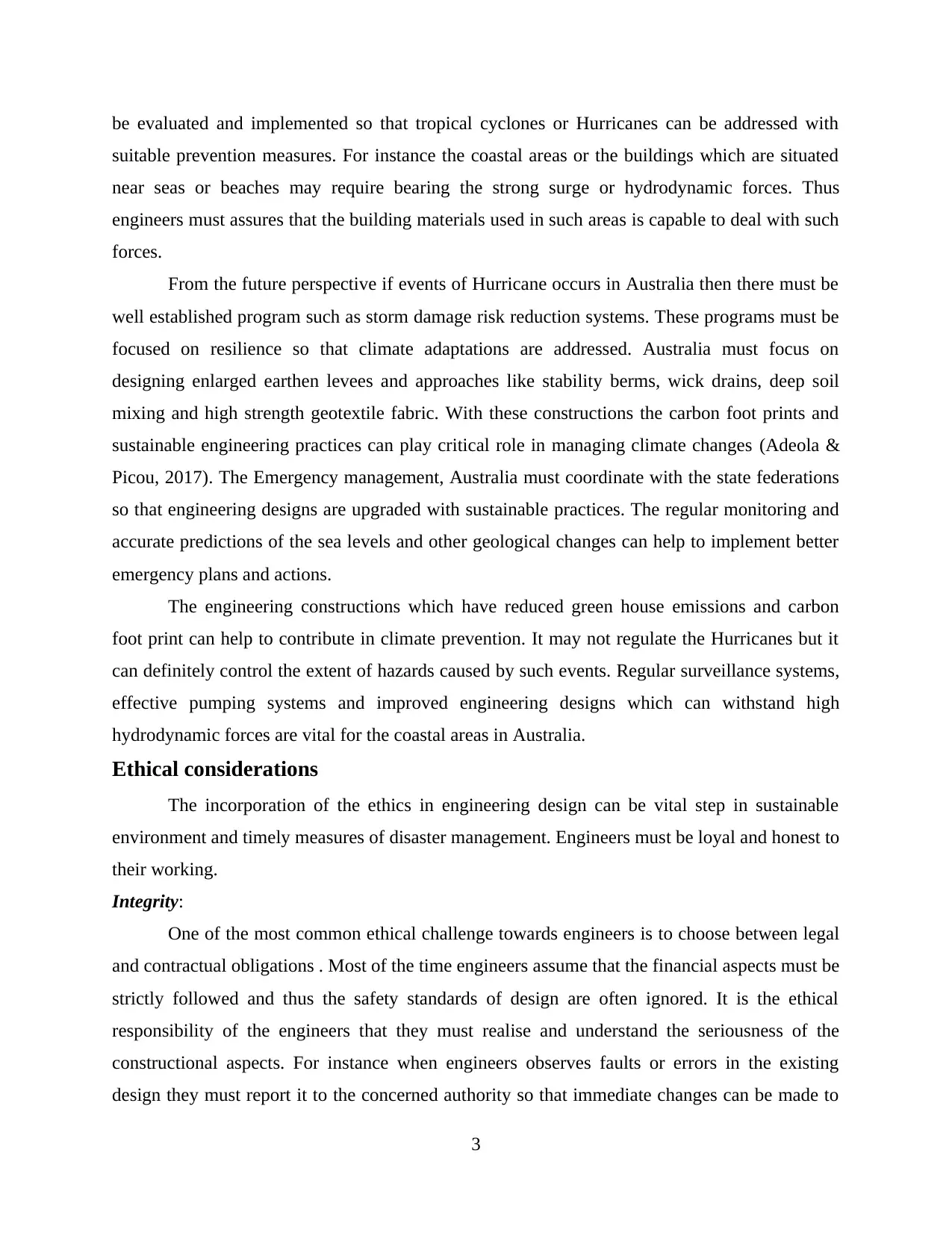
be evaluated and implemented so that tropical cyclones or Hurricanes can be addressed with
suitable prevention measures. For instance the coastal areas or the buildings which are situated
near seas or beaches may require bearing the strong surge or hydrodynamic forces. Thus
engineers must assures that the building materials used in such areas is capable to deal with such
forces.
From the future perspective if events of Hurricane occurs in Australia then there must be
well established program such as storm damage risk reduction systems. These programs must be
focused on resilience so that climate adaptations are addressed. Australia must focus on
designing enlarged earthen levees and approaches like stability berms, wick drains, deep soil
mixing and high strength geotextile fabric. With these constructions the carbon foot prints and
sustainable engineering practices can play critical role in managing climate changes (Adeola &
Picou, 2017). The Emergency management, Australia must coordinate with the state federations
so that engineering designs are upgraded with sustainable practices. The regular monitoring and
accurate predictions of the sea levels and other geological changes can help to implement better
emergency plans and actions.
The engineering constructions which have reduced green house emissions and carbon
foot print can help to contribute in climate prevention. It may not regulate the Hurricanes but it
can definitely control the extent of hazards caused by such events. Regular surveillance systems,
effective pumping systems and improved engineering designs which can withstand high
hydrodynamic forces are vital for the coastal areas in Australia.
Ethical considerations
The incorporation of the ethics in engineering design can be vital step in sustainable
environment and timely measures of disaster management. Engineers must be loyal and honest to
their working.
Integrity:
One of the most common ethical challenge towards engineers is to choose between legal
and contractual obligations . Most of the time engineers assume that the financial aspects must be
strictly followed and thus the safety standards of design are often ignored. It is the ethical
responsibility of the engineers that they must realise and understand the seriousness of the
constructional aspects. For instance when engineers observes faults or errors in the existing
design they must report it to the concerned authority so that immediate changes can be made to
3
suitable prevention measures. For instance the coastal areas or the buildings which are situated
near seas or beaches may require bearing the strong surge or hydrodynamic forces. Thus
engineers must assures that the building materials used in such areas is capable to deal with such
forces.
From the future perspective if events of Hurricane occurs in Australia then there must be
well established program such as storm damage risk reduction systems. These programs must be
focused on resilience so that climate adaptations are addressed. Australia must focus on
designing enlarged earthen levees and approaches like stability berms, wick drains, deep soil
mixing and high strength geotextile fabric. With these constructions the carbon foot prints and
sustainable engineering practices can play critical role in managing climate changes (Adeola &
Picou, 2017). The Emergency management, Australia must coordinate with the state federations
so that engineering designs are upgraded with sustainable practices. The regular monitoring and
accurate predictions of the sea levels and other geological changes can help to implement better
emergency plans and actions.
The engineering constructions which have reduced green house emissions and carbon
foot print can help to contribute in climate prevention. It may not regulate the Hurricanes but it
can definitely control the extent of hazards caused by such events. Regular surveillance systems,
effective pumping systems and improved engineering designs which can withstand high
hydrodynamic forces are vital for the coastal areas in Australia.
Ethical considerations
The incorporation of the ethics in engineering design can be vital step in sustainable
environment and timely measures of disaster management. Engineers must be loyal and honest to
their working.
Integrity:
One of the most common ethical challenge towards engineers is to choose between legal
and contractual obligations . Most of the time engineers assume that the financial aspects must be
strictly followed and thus the safety standards of design are often ignored. It is the ethical
responsibility of the engineers that they must realise and understand the seriousness of the
constructional aspects. For instance when engineers observes faults or errors in the existing
design they must report it to the concerned authority so that immediate changes can be made to
3
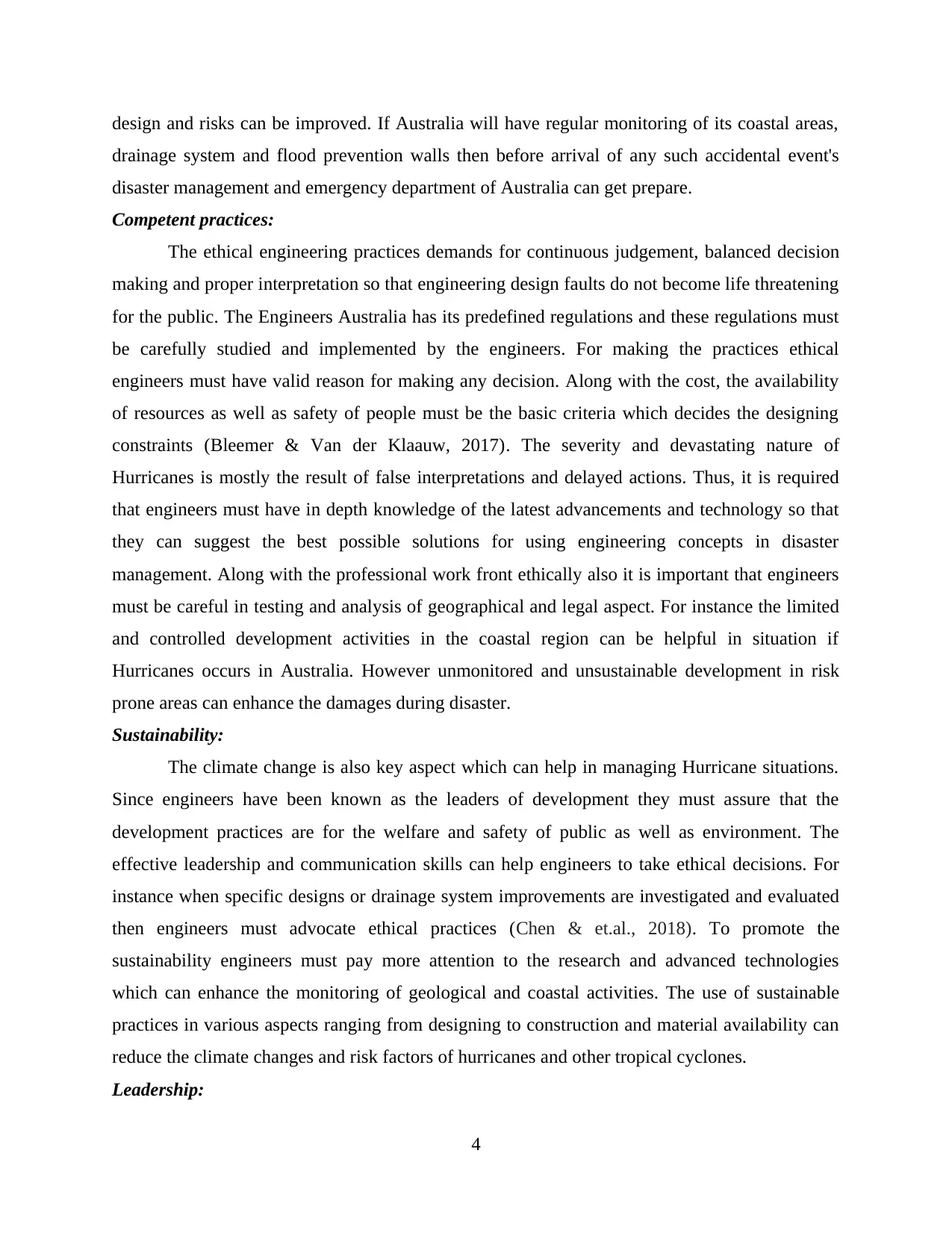
design and risks can be improved. If Australia will have regular monitoring of its coastal areas,
drainage system and flood prevention walls then before arrival of any such accidental event's
disaster management and emergency department of Australia can get prepare.
Competent practices:
The ethical engineering practices demands for continuous judgement, balanced decision
making and proper interpretation so that engineering design faults do not become life threatening
for the public. The Engineers Australia has its predefined regulations and these regulations must
be carefully studied and implemented by the engineers. For making the practices ethical
engineers must have valid reason for making any decision. Along with the cost, the availability
of resources as well as safety of people must be the basic criteria which decides the designing
constraints (Bleemer & Van der Klaauw, 2017). The severity and devastating nature of
Hurricanes is mostly the result of false interpretations and delayed actions. Thus, it is required
that engineers must have in depth knowledge of the latest advancements and technology so that
they can suggest the best possible solutions for using engineering concepts in disaster
management. Along with the professional work front ethically also it is important that engineers
must be careful in testing and analysis of geographical and legal aspect. For instance the limited
and controlled development activities in the coastal region can be helpful in situation if
Hurricanes occurs in Australia. However unmonitored and unsustainable development in risk
prone areas can enhance the damages during disaster.
Sustainability:
The climate change is also key aspect which can help in managing Hurricane situations.
Since engineers have been known as the leaders of development they must assure that the
development practices are for the welfare and safety of public as well as environment. The
effective leadership and communication skills can help engineers to take ethical decisions. For
instance when specific designs or drainage system improvements are investigated and evaluated
then engineers must advocate ethical practices (Chen & et.al., 2018). To promote the
sustainability engineers must pay more attention to the research and advanced technologies
which can enhance the monitoring of geological and coastal activities. The use of sustainable
practices in various aspects ranging from designing to construction and material availability can
reduce the climate changes and risk factors of hurricanes and other tropical cyclones.
Leadership:
4
drainage system and flood prevention walls then before arrival of any such accidental event's
disaster management and emergency department of Australia can get prepare.
Competent practices:
The ethical engineering practices demands for continuous judgement, balanced decision
making and proper interpretation so that engineering design faults do not become life threatening
for the public. The Engineers Australia has its predefined regulations and these regulations must
be carefully studied and implemented by the engineers. For making the practices ethical
engineers must have valid reason for making any decision. Along with the cost, the availability
of resources as well as safety of people must be the basic criteria which decides the designing
constraints (Bleemer & Van der Klaauw, 2017). The severity and devastating nature of
Hurricanes is mostly the result of false interpretations and delayed actions. Thus, it is required
that engineers must have in depth knowledge of the latest advancements and technology so that
they can suggest the best possible solutions for using engineering concepts in disaster
management. Along with the professional work front ethically also it is important that engineers
must be careful in testing and analysis of geographical and legal aspect. For instance the limited
and controlled development activities in the coastal region can be helpful in situation if
Hurricanes occurs in Australia. However unmonitored and unsustainable development in risk
prone areas can enhance the damages during disaster.
Sustainability:
The climate change is also key aspect which can help in managing Hurricane situations.
Since engineers have been known as the leaders of development they must assure that the
development practices are for the welfare and safety of public as well as environment. The
effective leadership and communication skills can help engineers to take ethical decisions. For
instance when specific designs or drainage system improvements are investigated and evaluated
then engineers must advocate ethical practices (Chen & et.al., 2018). To promote the
sustainability engineers must pay more attention to the research and advanced technologies
which can enhance the monitoring of geological and coastal activities. The use of sustainable
practices in various aspects ranging from designing to construction and material availability can
reduce the climate changes and risk factors of hurricanes and other tropical cyclones.
Leadership:
4
⊘ This is a preview!⊘
Do you want full access?
Subscribe today to unlock all pages.

Trusted by 1+ million students worldwide
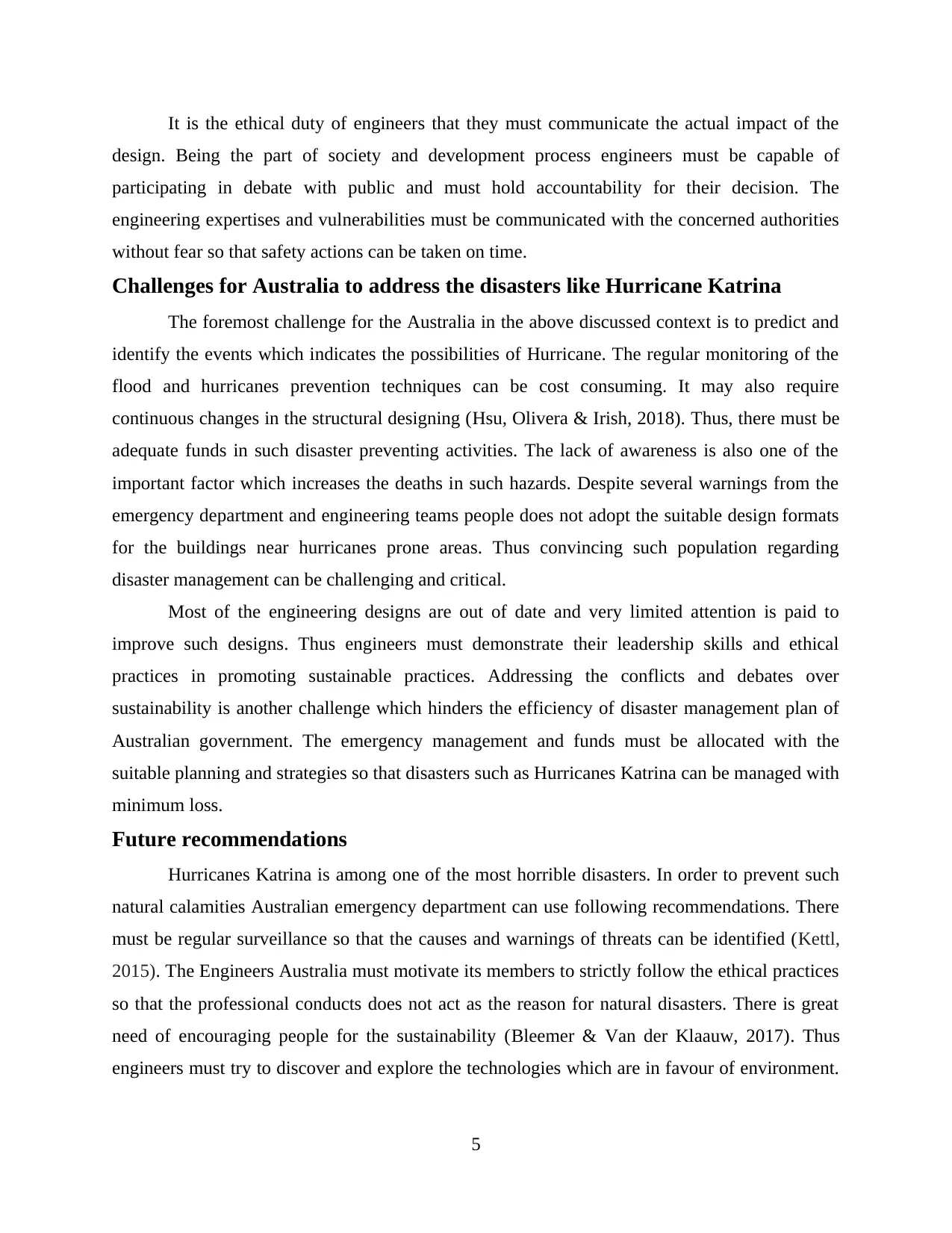
It is the ethical duty of engineers that they must communicate the actual impact of the
design. Being the part of society and development process engineers must be capable of
participating in debate with public and must hold accountability for their decision. The
engineering expertises and vulnerabilities must be communicated with the concerned authorities
without fear so that safety actions can be taken on time.
Challenges for Australia to address the disasters like Hurricane Katrina
The foremost challenge for the Australia in the above discussed context is to predict and
identify the events which indicates the possibilities of Hurricane. The regular monitoring of the
flood and hurricanes prevention techniques can be cost consuming. It may also require
continuous changes in the structural designing (Hsu, Olivera & Irish, 2018). Thus, there must be
adequate funds in such disaster preventing activities. The lack of awareness is also one of the
important factor which increases the deaths in such hazards. Despite several warnings from the
emergency department and engineering teams people does not adopt the suitable design formats
for the buildings near hurricanes prone areas. Thus convincing such population regarding
disaster management can be challenging and critical.
Most of the engineering designs are out of date and very limited attention is paid to
improve such designs. Thus engineers must demonstrate their leadership skills and ethical
practices in promoting sustainable practices. Addressing the conflicts and debates over
sustainability is another challenge which hinders the efficiency of disaster management plan of
Australian government. The emergency management and funds must be allocated with the
suitable planning and strategies so that disasters such as Hurricanes Katrina can be managed with
minimum loss.
Future recommendations
Hurricanes Katrina is among one of the most horrible disasters. In order to prevent such
natural calamities Australian emergency department can use following recommendations. There
must be regular surveillance so that the causes and warnings of threats can be identified (Kettl,
2015). The Engineers Australia must motivate its members to strictly follow the ethical practices
so that the professional conducts does not act as the reason for natural disasters. There is great
need of encouraging people for the sustainability (Bleemer & Van der Klaauw, 2017). Thus
engineers must try to discover and explore the technologies which are in favour of environment.
5
design. Being the part of society and development process engineers must be capable of
participating in debate with public and must hold accountability for their decision. The
engineering expertises and vulnerabilities must be communicated with the concerned authorities
without fear so that safety actions can be taken on time.
Challenges for Australia to address the disasters like Hurricane Katrina
The foremost challenge for the Australia in the above discussed context is to predict and
identify the events which indicates the possibilities of Hurricane. The regular monitoring of the
flood and hurricanes prevention techniques can be cost consuming. It may also require
continuous changes in the structural designing (Hsu, Olivera & Irish, 2018). Thus, there must be
adequate funds in such disaster preventing activities. The lack of awareness is also one of the
important factor which increases the deaths in such hazards. Despite several warnings from the
emergency department and engineering teams people does not adopt the suitable design formats
for the buildings near hurricanes prone areas. Thus convincing such population regarding
disaster management can be challenging and critical.
Most of the engineering designs are out of date and very limited attention is paid to
improve such designs. Thus engineers must demonstrate their leadership skills and ethical
practices in promoting sustainable practices. Addressing the conflicts and debates over
sustainability is another challenge which hinders the efficiency of disaster management plan of
Australian government. The emergency management and funds must be allocated with the
suitable planning and strategies so that disasters such as Hurricanes Katrina can be managed with
minimum loss.
Future recommendations
Hurricanes Katrina is among one of the most horrible disasters. In order to prevent such
natural calamities Australian emergency department can use following recommendations. There
must be regular surveillance so that the causes and warnings of threats can be identified (Kettl,
2015). The Engineers Australia must motivate its members to strictly follow the ethical practices
so that the professional conducts does not act as the reason for natural disasters. There is great
need of encouraging people for the sustainability (Bleemer & Van der Klaauw, 2017). Thus
engineers must try to discover and explore the technologies which are in favour of environment.
5
Paraphrase This Document
Need a fresh take? Get an instant paraphrase of this document with our AI Paraphraser
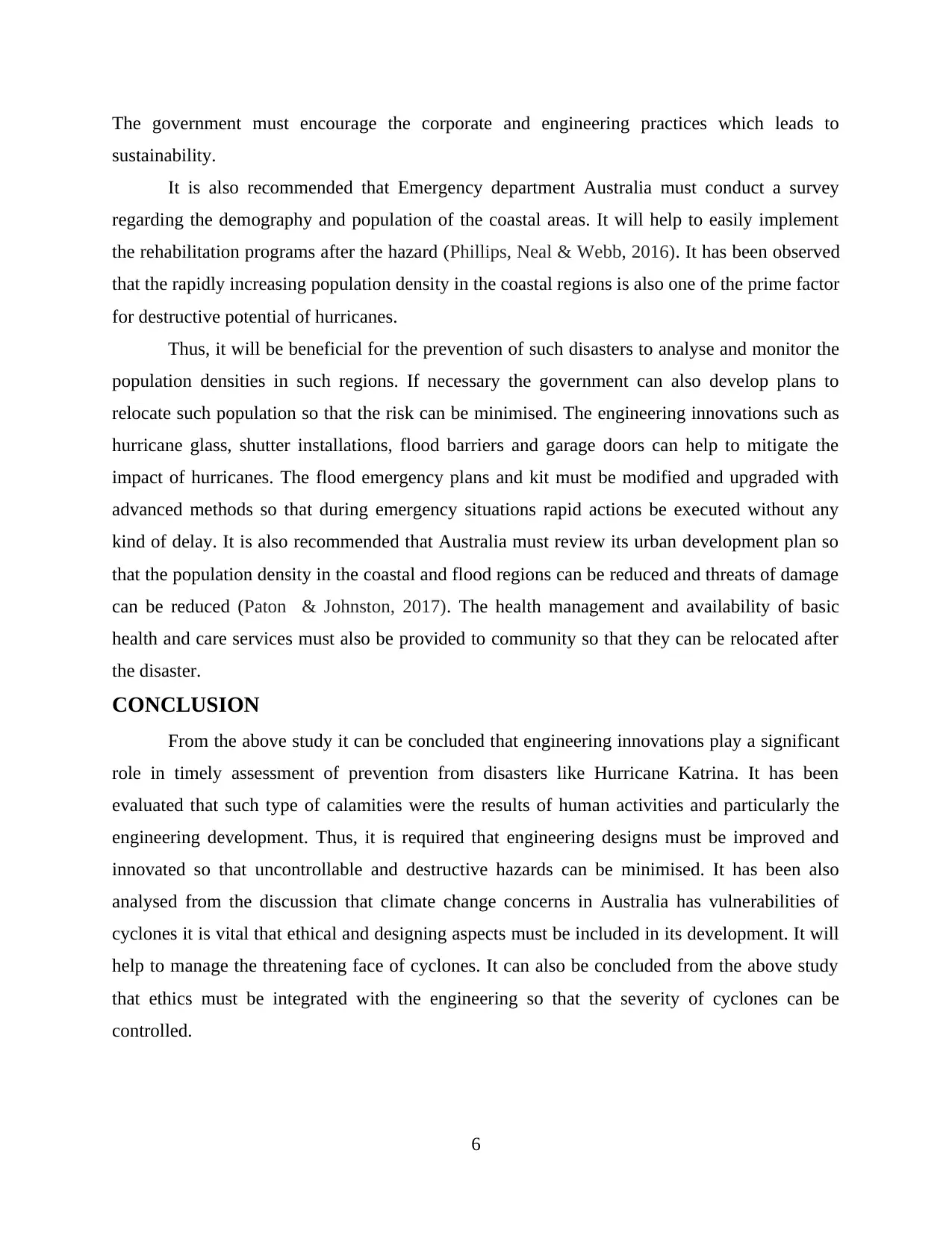
The government must encourage the corporate and engineering practices which leads to
sustainability.
It is also recommended that Emergency department Australia must conduct a survey
regarding the demography and population of the coastal areas. It will help to easily implement
the rehabilitation programs after the hazard (Phillips, Neal & Webb, 2016). It has been observed
that the rapidly increasing population density in the coastal regions is also one of the prime factor
for destructive potential of hurricanes.
Thus, it will be beneficial for the prevention of such disasters to analyse and monitor the
population densities in such regions. If necessary the government can also develop plans to
relocate such population so that the risk can be minimised. The engineering innovations such as
hurricane glass, shutter installations, flood barriers and garage doors can help to mitigate the
impact of hurricanes. The flood emergency plans and kit must be modified and upgraded with
advanced methods so that during emergency situations rapid actions be executed without any
kind of delay. It is also recommended that Australia must review its urban development plan so
that the population density in the coastal and flood regions can be reduced and threats of damage
can be reduced (Paton & Johnston, 2017). The health management and availability of basic
health and care services must also be provided to community so that they can be relocated after
the disaster.
CONCLUSION
From the above study it can be concluded that engineering innovations play a significant
role in timely assessment of prevention from disasters like Hurricane Katrina. It has been
evaluated that such type of calamities were the results of human activities and particularly the
engineering development. Thus, it is required that engineering designs must be improved and
innovated so that uncontrollable and destructive hazards can be minimised. It has been also
analysed from the discussion that climate change concerns in Australia has vulnerabilities of
cyclones it is vital that ethical and designing aspects must be included in its development. It will
help to manage the threatening face of cyclones. It can also be concluded from the above study
that ethics must be integrated with the engineering so that the severity of cyclones can be
controlled.
6
sustainability.
It is also recommended that Emergency department Australia must conduct a survey
regarding the demography and population of the coastal areas. It will help to easily implement
the rehabilitation programs after the hazard (Phillips, Neal & Webb, 2016). It has been observed
that the rapidly increasing population density in the coastal regions is also one of the prime factor
for destructive potential of hurricanes.
Thus, it will be beneficial for the prevention of such disasters to analyse and monitor the
population densities in such regions. If necessary the government can also develop plans to
relocate such population so that the risk can be minimised. The engineering innovations such as
hurricane glass, shutter installations, flood barriers and garage doors can help to mitigate the
impact of hurricanes. The flood emergency plans and kit must be modified and upgraded with
advanced methods so that during emergency situations rapid actions be executed without any
kind of delay. It is also recommended that Australia must review its urban development plan so
that the population density in the coastal and flood regions can be reduced and threats of damage
can be reduced (Paton & Johnston, 2017). The health management and availability of basic
health and care services must also be provided to community so that they can be relocated after
the disaster.
CONCLUSION
From the above study it can be concluded that engineering innovations play a significant
role in timely assessment of prevention from disasters like Hurricane Katrina. It has been
evaluated that such type of calamities were the results of human activities and particularly the
engineering development. Thus, it is required that engineering designs must be improved and
innovated so that uncontrollable and destructive hazards can be minimised. It has been also
analysed from the discussion that climate change concerns in Australia has vulnerabilities of
cyclones it is vital that ethical and designing aspects must be included in its development. It will
help to manage the threatening face of cyclones. It can also be concluded from the above study
that ethics must be integrated with the engineering so that the severity of cyclones can be
controlled.
6
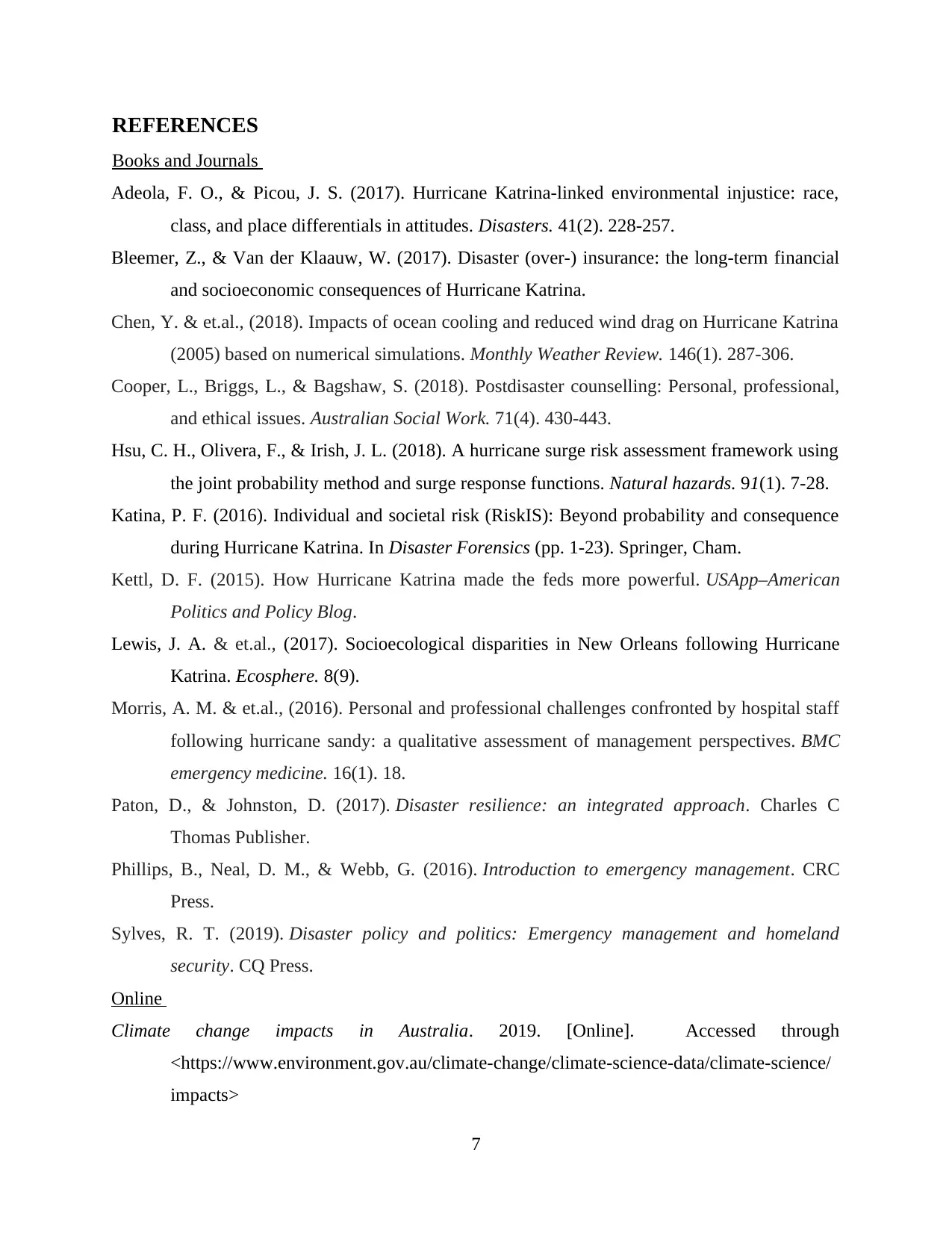
REFERENCES
Books and Journals
Adeola, F. O., & Picou, J. S. (2017). Hurricane Katrina‐linked environmental injustice: race,
class, and place differentials in attitudes. Disasters. 41(2). 228-257.
Bleemer, Z., & Van der Klaauw, W. (2017). Disaster (over-) insurance: the long-term financial
and socioeconomic consequences of Hurricane Katrina.
Chen, Y. & et.al., (2018). Impacts of ocean cooling and reduced wind drag on Hurricane Katrina
(2005) based on numerical simulations. Monthly Weather Review. 146(1). 287-306.
Cooper, L., Briggs, L., & Bagshaw, S. (2018). Postdisaster counselling: Personal, professional,
and ethical issues. Australian Social Work. 71(4). 430-443.
Hsu, C. H., Olivera, F., & Irish, J. L. (2018). A hurricane surge risk assessment framework using
the joint probability method and surge response functions. Natural hazards. 91(1). 7-28.
Katina, P. F. (2016). Individual and societal risk (RiskIS): Beyond probability and consequence
during Hurricane Katrina. In Disaster Forensics (pp. 1-23). Springer, Cham.
Kettl, D. F. (2015). How Hurricane Katrina made the feds more powerful. USApp–American
Politics and Policy Blog.
Lewis, J. A. & et.al., (2017). Socioecological disparities in New Orleans following Hurricane
Katrina. Ecosphere. 8(9).
Morris, A. M. & et.al., (2016). Personal and professional challenges confronted by hospital staff
following hurricane sandy: a qualitative assessment of management perspectives. BMC
emergency medicine. 16(1). 18.
Paton, D., & Johnston, D. (2017). Disaster resilience: an integrated approach. Charles C
Thomas Publisher.
Phillips, B., Neal, D. M., & Webb, G. (2016). Introduction to emergency management. CRC
Press.
Sylves, R. T. (2019). Disaster policy and politics: Emergency management and homeland
security. CQ Press.
Online
Climate change impacts in Australia. 2019. [Online]. Accessed through
<https://www.environment.gov.au/climate-change/climate-science-data/climate-science/
impacts>
7
Books and Journals
Adeola, F. O., & Picou, J. S. (2017). Hurricane Katrina‐linked environmental injustice: race,
class, and place differentials in attitudes. Disasters. 41(2). 228-257.
Bleemer, Z., & Van der Klaauw, W. (2017). Disaster (over-) insurance: the long-term financial
and socioeconomic consequences of Hurricane Katrina.
Chen, Y. & et.al., (2018). Impacts of ocean cooling and reduced wind drag on Hurricane Katrina
(2005) based on numerical simulations. Monthly Weather Review. 146(1). 287-306.
Cooper, L., Briggs, L., & Bagshaw, S. (2018). Postdisaster counselling: Personal, professional,
and ethical issues. Australian Social Work. 71(4). 430-443.
Hsu, C. H., Olivera, F., & Irish, J. L. (2018). A hurricane surge risk assessment framework using
the joint probability method and surge response functions. Natural hazards. 91(1). 7-28.
Katina, P. F. (2016). Individual and societal risk (RiskIS): Beyond probability and consequence
during Hurricane Katrina. In Disaster Forensics (pp. 1-23). Springer, Cham.
Kettl, D. F. (2015). How Hurricane Katrina made the feds more powerful. USApp–American
Politics and Policy Blog.
Lewis, J. A. & et.al., (2017). Socioecological disparities in New Orleans following Hurricane
Katrina. Ecosphere. 8(9).
Morris, A. M. & et.al., (2016). Personal and professional challenges confronted by hospital staff
following hurricane sandy: a qualitative assessment of management perspectives. BMC
emergency medicine. 16(1). 18.
Paton, D., & Johnston, D. (2017). Disaster resilience: an integrated approach. Charles C
Thomas Publisher.
Phillips, B., Neal, D. M., & Webb, G. (2016). Introduction to emergency management. CRC
Press.
Sylves, R. T. (2019). Disaster policy and politics: Emergency management and homeland
security. CQ Press.
Online
Climate change impacts in Australia. 2019. [Online]. Accessed through
<https://www.environment.gov.au/climate-change/climate-science-data/climate-science/
impacts>
7
⊘ This is a preview!⊘
Do you want full access?
Subscribe today to unlock all pages.

Trusted by 1+ million students worldwide
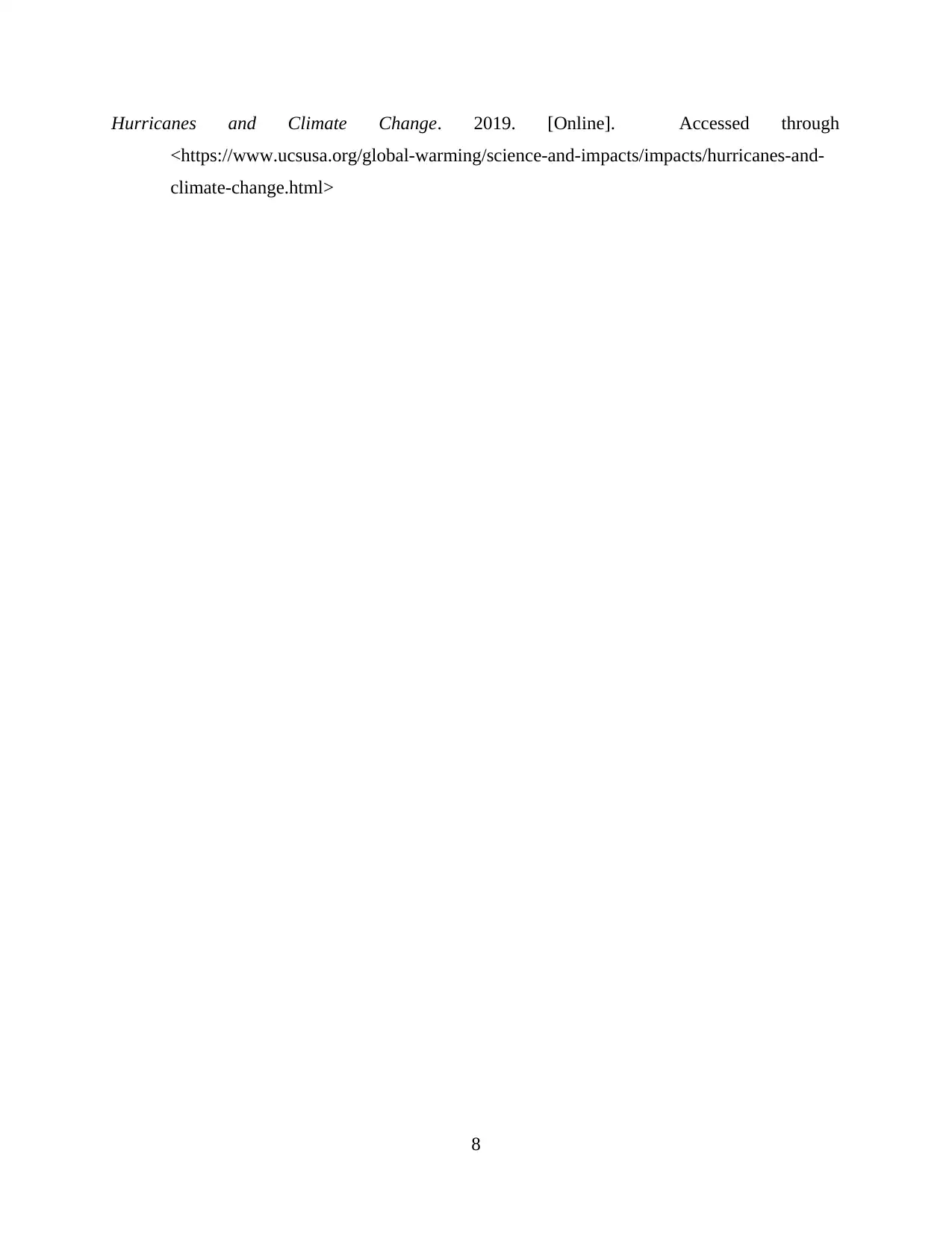
Hurricanes and Climate Change. 2019. [Online]. Accessed through
<https://www.ucsusa.org/global-warming/science-and-impacts/impacts/hurricanes-and-
climate-change.html>
8
<https://www.ucsusa.org/global-warming/science-and-impacts/impacts/hurricanes-and-
climate-change.html>
8
Paraphrase This Document
Need a fresh take? Get an instant paraphrase of this document with our AI Paraphraser

9

10
⊘ This is a preview!⊘
Do you want full access?
Subscribe today to unlock all pages.

Trusted by 1+ million students worldwide
1 out of 14
Related Documents
Your All-in-One AI-Powered Toolkit for Academic Success.
+13062052269
info@desklib.com
Available 24*7 on WhatsApp / Email
![[object Object]](/_next/static/media/star-bottom.7253800d.svg)
Unlock your academic potential
Copyright © 2020–2025 A2Z Services. All Rights Reserved. Developed and managed by ZUCOL.





